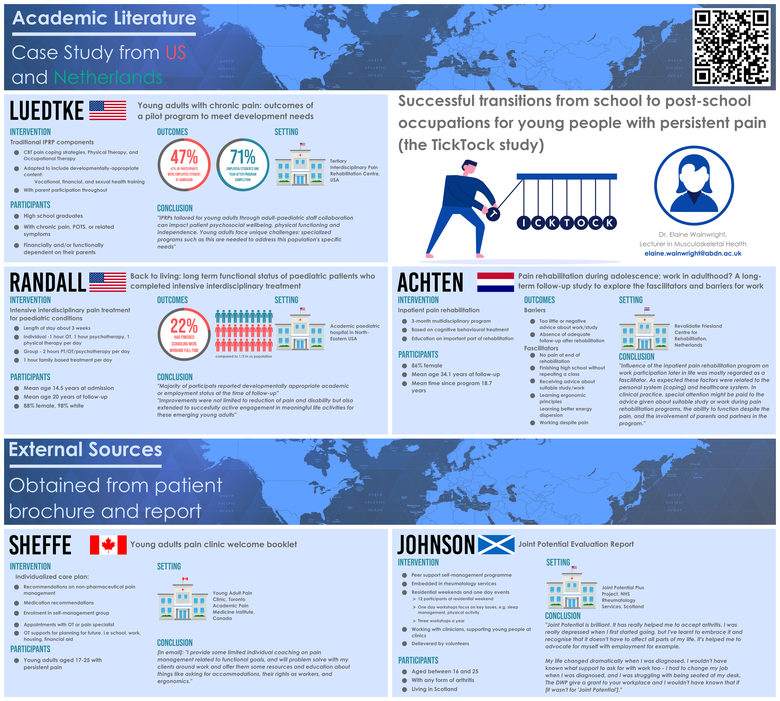
Duration: 01 May 2022 - 30 September 2022
Funder: Wellcome Trust Institutional Strategic Support Fund (ISSF)
Chief investigator: Dr Elaine Wainwright
Co-investigators: Dr Rosemary Hollick, Professor Gareth Jones, Dr Dan Powell
Associated research staff: Dr Marcus Beasley
Transitioning from paediatric to adult healthcare is challenging for youth in the UK living with persistent pain. We know little about how to support their transition from school to post-school occupations such as work, university or an apprenticeship. It is vital to optimise their vocational support needs. This is because for nearly everyone, including those living with pain, safe and appropriate work supports positive physical and psychosocial outcomes. However, pain disrupts working lives. There is much research on how to enable work for older adults aged 30 and over who live with pain, but little on younger adults aged 19-30, and very little indeed on young people who are coming to the end of formal schooling and transitioning into post-school occupations (14-19).
This scoping project will enable three key pump-priming activities for a large funding application. First, we will interrogate a range of large datasets with health and work outcomes, to see if they have sufficient granularity to answer research questions about risk factors for poor occupational outcomes for young people living with pain. Second, we will conduct a rapid evidence review of current vocational support for this group. Third, there will be a round-table event for research, practitioner, and policy experts to plan the larger application.

- What is the background to this research?
-
We know that transitioning from paediatric to adult healthcare is challenging for young people in the UK who live with persistent pain. However, we know very little about how to support those living with persistent pain aged 14-19, to transition from school to post-school occupations (including paid and unpaid work, university, apprenticeships). It is vital to optimise the vocational support needs of this cohort of young people. This is because for nearly all of us, including those living with pain, safe and appropriate work supports positive physical and psychosocial outcomes. While there is much research on how to enable work for older adults aged 30 and over who live with pain, there is little on younger adults aged 18-30, and very little indeed on young people who are coming to the end of formal schooling and transitioning into post-school occupations.
It is clear that pain disrupts working lives. Pain may be linked to a number of different factors; inflammatory rheumatic conditions such as juvenile idiopathic arthritis, non-inflammatory conditions such as joint hypermobility, as well as those with pain who do not have a specific diagnosis. Persistent pain, lasting three months or more, will be the defining feature of what the young people are living with, irrespective of underlying pathology. This is consistent with the ICD-11 recognition that pain can be considered a disabling condition in its own right. At present, we also anticipate that the young people who are living with persistent pain may be on a continuum, from those who attend school regularly, right through to those living with extreme disabling pain, such that it is difficult to engage with school.
- What will this research involve?
-
Activity 1: Database interrogation
We will first interrogate a range of datasets with health and work outcomes to see if they have sufficient granularity to answer research questions about potential risk factors for poor occupational outcomes for young people living with pain. We will investigate population-based longitudinal studies to see if we would be able to examine patterns of employment, unemployment, transitions between them, and other beneficial occupational activities such as attending university, for young people living with pain who are leaving school, starting with cases aged 14 (as this is when many vocational considerations arise in school and in young people’s development) and following cases until approximately age 30.
We will bring the results of this work to the round table to make final decisions about which studies could be used in analyses, depending on whether relevant data have been collected and are available in a format suitable for analysis. Collating meta-data on candidate datasets around pain and work/further education in younger people should also provide a useful resource in terms of other future studies within the CMHW too. From our initial scoping of which datasets may be relevant, we consider that the Avon Longitudinal Study of Children and Parents (ALSPAC), the Millennium Cohort Study, the British Cohort Study, Next Steps, and Understanding Society are likely candidates.
Activity 2: Rapid evidence review
We will conduct a rapid evidence review of current vocational and occupational support for young people aged 14-19 with persistent pain, including within educational, healthcare and non-healthcare community settings. This is important as there is no clear evidence of what is actually available to support young people aged 14-19 in pain as they transition from school to post-school occupation, including paid and unpaid work, apprenticeships, and university. We also want to know if available interventions work or not. Barriers and enablers to transitions may be because (a) support simply does not exist; (b) support does exist but is not readily available or accessible to all who need it; (c) available support is not effective or (d) a combination of all of above. The rapid review will scope out what does work when, for whom, and why.
Activity 3: Round table of key stakeholders to plan the larger bid
Finally, we will conduct a round-table event for research, practitioner and policy experts, and key stakeholders including the young people themselves. At this event, we will report on the findings of activities one and two, and use these findings to plan the larger bid. Confirmed round table attendees include: patient partners from the University of Aberdeen Epidemiology PPIE group, relevant policy-makers and programme managers, clinicians, third sector representatives and researchers. Invited researchers will span pain science, paediatric pain psychology, occupational health, occupational medicine, health psychology, educational psychology, epidemiology, health economics and review methodology. Crucially, we will also ensure we include representatives from the young people’s cohort, and some of the support services that are identified in the earlier two pump-priming activities. The round table is designed to be interdisciplinary, as are the three activities proposed here, in order to prepare our large grant application, which itself will be highly interdisciplinary, in order to solve a challenging and pressing problem.
- What has the study found so far?
-
Research work for this study began in June 2022. You can read the review protocol here.
You can view a presentation with some early results of the review here
You can also view a summary of the main findings in the infographic below (click the image to zoom in / open in a new window):
- Contact
-
If you have any queries about this research, please contact elaine.wainwright@abdn.ac.uk

